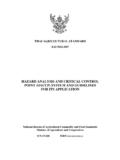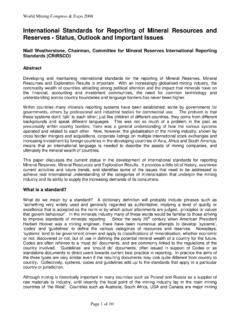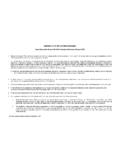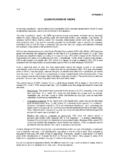Transcription of THE 2002 US BENCHMARK VERSION OF THE ECONOMIC …
1 1 THE 2002 US BENCHMARK VERSION OF THE ECONOMIC input - output life cycle assessment (EIO-LCA) MODEL BY CHRISTOPHER WEBER, DEANNA MATTHEWS, ARANYA VENKATESH, CHRISTINE COSTELLO, AND H. SCOTT MATTHEWS GREEN DESIGN INSTITUTE, CARNEGIE MELLON UNIVERSITY JUNE 16, 2009 LAST REVISED 4/23/10 1. INTRODUCTION The 2002 EIO-LCA BENCHMARK model of the US Economy, like the other models available on the website, is based upon a variety of public data sources. The ECONOMIC part of the model is built upon the inter-sector input - output transactions of the US economy as compiled by the Bureau of ECONOMIC Analysis (BEA) of the US Department of Commerce (BEA 2008). The BENCHMARK input - output tables are based upon a variety of census data sources and represents more detailed estimates and provides the basis for the BEA s annual input - output tables.
2 To this basic BENCHMARK input - output model, we have added a series of emission and resource use vectors (Hendrickson 2005). This document describes the calculations and transformations used to produce these various impact vectors. Sections in this report include details on the following pieces of this EIO-LCA model: a. ECONOMIC input - output data b. Energy Use c. Global Warming Potential Emissions Also included are four appendices in a separate volume: 1. 2002 NAICS to input - output Sector Mappings 2. 2002 input - output Commodity Sector Outputs 2. DESCRIPTION OF THE ECONOMIC MATRICES USED IN THE 2002 BENCHMARK MODEL OF THE US ECONOMY The ECONOMIC model used on the EIO-LCA website is based on the 2002 commodity by industry (C x I) model of the US BEA [BEA 2008]. Note that this model is slightly different than earlier year BENCHMARK models used on the EIO-LCA website ( , the industry-by-industry models).
3 Industry by industry models link output of an industry with the industries that support production, , the required input into the model is the relevant amount of ECONOMIC output of an industry, and the results are the outputs of various industry sectors needed to support that production. C x I models on the other hand have input into the model of commodity output , and link the results to production from industry sectors. Inevitably, the differences in industry or commodity basis are small (and generally restricted to a subset of sectors). The 2002 C x I model as created by the BEA is connected to NAICS sectors of the economy (the bridge between the 2002 C x I model sectors and underlying NAICS sectors is shown in Appendix A as provided by the BEA). For further descriptions of the underlying bridges and mapping files used 2 in the EIO-LCA BENCHMARK models of the US economy, please refer to the documentation of the 1997 BENCHMARK model.
4 Before detailing various specific assumptions and adjustment made to create the workfiles for the 2002 C x I model, we note the basis of the most common assumption made in linking data in the model. Consistent with ISO practice [ISO 2006], we by default use ECONOMIC allocation as the way of assigning effects to sectors. Again, unless stated otherwise we use ECONOMIC allocation (as shown above) to estimate effects in the model when provided with data at a more or less disaggregated level. 3. ESTIMATION OF THE ELECTRICITY AND FUEL USE DATA IN THE 2002 US CXI EIO-LCA MODEL The energy data used in the 2002 US CxI EIO-LCA model is derived from several additional sources, generally for three aggregated sectors (minerals, manufacturing, transportation). The energy/fuel data are also the main required underlying data sources to estimate GHG emissions for the sectors.
5 Compared to previous US models, we have aggregated the detail of energy/fuel sources to only coal, natural gas, petroleum based fuels, biomass/waste, and non-fossil electricity. In previous years more disaggregated estimates were also given ( , for gasoline, diesel, etc.). This new aggregation was done partly because the effort required to further disaggregate petroleum-based fuels is significant, requiring many assumptions and leading to uncertainties, and since relatively few sectors have a diverse mix of fuels, and thus the type of petroleum-based fuel being used in a sector can be easily assumed if needed ( , the air transportation sector mostly uses jet fuel). Note that we are still finalizing our method to include estimated on-site electricity generation (including associated GHG emissions), with an estimated completion time of summer 2009.
6 Effects of site-generated electricity are relevant for only a small number of sectors ( , paper and aluminum). Mineral Sectors For the 11 mineral sectors (sectors whose first 3 digits start with 211-213, seen in Appendix A), the 2002 Fuel and Electric Energy Report published by the Census Bureau [Census 2002b] was used. This document reports fuel and electricity usage in physical units ( , short ton, barrel, cubic feet, gallon and kWh) as well as in some cases ECONOMIC expenditures for the mineral sectors in 2002. Fuels presented in this report include electricity, coal, natural gas, and various petroleum-based fuels, which we again aggregate into the fuels listed above. Sectoral fuel use was calculated in terajoules (TJ) using the conversion factors shown in Table 3-1 and 3-2. 3 barrel (petroleum)= 42 gallons barrel crude petroleum= 5800000 BTU short ton anthracite coal= 25400000 BTU short ton bit & lig= 26200000 BTU 1000 cu.
7 Ft. natural gas= 1035000 BTU barrel distillate fuel oil= 5825000 BTU barrel residual fuel oil= 6287000 BTU barrel LPG= 4011000 BTU barrel gasoline= 5248000 BTU barrel kerosine= 5670000 BTU barrel natural gasoline= 4620000 BTU BTU= Joules TBTU= 1055100 GJ Table 3-1: Conversion factors [API 2005] Finally, the use of fuels for each sector were divided by the industry outputs to obtain the fuel use factors in TJ/$million. The industry outputs are presented in Appendix B. The following ECONOMIC assumptions were used to convert dollar-valued purchases of fuels into physical units. Motor Gasoline $/gal Aviation Gasoline $/gal Kerosene-Type Jet Fuel $/gal Consumer Grade Propane and LPG $/gal Kerosene $/gal No. 1 Distillate $/gal No. 2 Distillate $/gal --No. 2 Diesel $/gal --No. 2 Fuel Oil $/gal No.
8 4 Distillate $/gal Residual Fuel Oil $/gal Table 3-2: Conversions from ECONOMIC to Physical Unit Values (EIA 2008) Agricultural Sectors For the 14 agricultural sectors (sectors whose first 3 digits start with 111 and 112, seen in Appendix A) the 2002 Census of Agriculture, specifically Table 59 was used [USDA 2002]. This document reports fuels as one category, gasoline, fuels, and oils and electricity usage in terms of expenditure by each of the NAICS codes included in the table. The 1997 Census of Agriculture included more detailed fuel expenditure information listing four fuel categories: gasoline and gasohol, diesel, natural gas, and LPG, fuel oil, kerosene, motor oil, grease, etc [USDA 1997]. The 1997 allocation of fuels within each sector was used to disaggregate the gasoline, fuels, and oils category within the 2002 Census.
9 Expenditures were converted into 4 physical units using additional values in Table 3-2a and values presented in Section , Tables 3-5 and 3-6. Physical units were converted into terajoules (TJ) using the conversion factors shown in Table 3-1. Petroleum Prices Assumed for Agricultural Fuel Use, 2002 Diesel $/gal [USDA 2005] Gasoline, bulk delivery $/gal [USDA 2005] LPG, bulk delivery $/gal [USDA 2005] Residual Oil $/gal [EIA 2010] Table 3-2a. Agriculture-specific Conversions from ECONOMIC to Physical Unit Values 5 Manufacturing sectors (all sectors from IO 311111 to IO 33999A) The electricity and fuel use for manufacturing sectors (representing 279 of the 426 sectors in the model) were estimated using data from the 2002 Manufacturing Energy Consumption Survey (MECS) [EIA 2006]. This report presents fuel and electricity usage in trillion BTU, in 3 to 6 digit NAICS forms with physical units of BTU.
10 Note that the specific MECS data required is for non-feedstock use of energy and fuels; as an example we do not consider feedstock use of petroleum for making plastics to be a use of petroleum in our data. For sake of explanation, Table 3-3 presents an excerpt of data reported in MECS. Since the MECS and IO data were from the same year, no further adjustments were made to the data. NAICS Code Major Group and Industry Total Net Electricity Residual Fuel Oil Distillate Fuel Oil Natural Gas LPG and NGL Coal Coke and Breeze Other 311 Food 870 212 12 19 528 5 26 0 34 311221 Wet corn milling 228 23 0 0 61 0 121 0 11 313 Textile Mill Products 220 86 4 2 74 2 22 0 15 315 Apparel and Other Textile Products 30 12 0 1 16 0 0 0 0 Table 3-3: Excerpt of data reported in 2002 MECS (Trillion BTU) [EIA 200x] Two tables of the overall MECS data were used for building the EIO-LCA model: table (fuel consumption for energy purposes) and table (selected byproducts for fuel consumption for energy purposes), which breaks up the other column of Table into 6 further categories.





